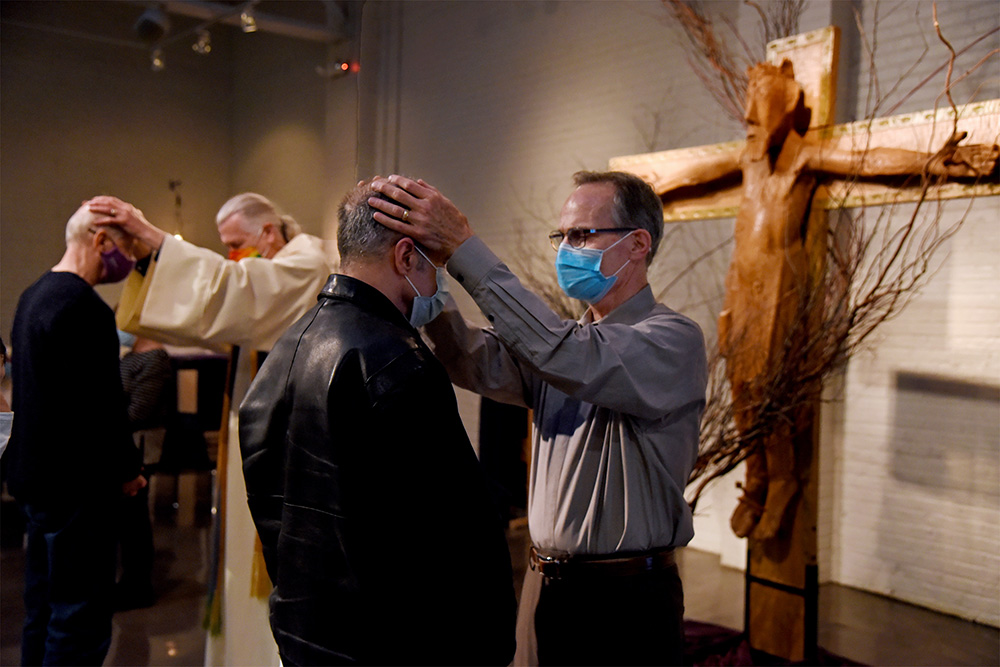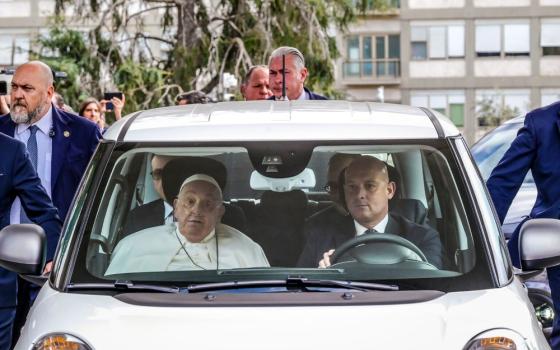
The reconciliation service at the Community of St. Peter in Cleveland during Lent 2022 (Courtesy of Community of St. Peter)
My family and I were still relatively new to Historic St. Peter Parish in Cleveland when we experienced our first communal reconciliation service within the community. Halfway through the first homily we heard from Fr. Robert Marrone, my 12-year-old son poked me and said: "This guy is interesting." My daughter came back from Communion chewing real bread and asked me: "Are there seconds?" We stayed.
At Historic St. Peter, the liturgical year offered both a freshness and a challenge from start to finish. The simplicity of the liturgy was as pleasing as the towering whitewashed walls and stone columns of the 150-year-old building. We assembled around the altar as one body for the eucharistic prayer. It felt appropriate.
It was just a week or so into Lent when I attended the evening reconciliation service. As one of nearly 200 people present, I was surprised to not see any other clergy milling about, ready to take their stations for the hearing of confessions. Instead, after an opening prayer, poignant Scripture readings and a provocative homily, only the pastor stood in front of a carved wooden crucifix as all present began to move forward.
The experience might not have satisfied a catechist looking for matter and form for the rite of reconciliation, but there was no doubt that the action was full of grace, mystery and more than enough forgiveness.
The line formed before the fourth-century cross and corpus. One by one, members paused within reach of the pastor for just a few moments. He placed his hands on the head of each penitent. Two heads bowed, an arm's length away. Then the next, and the next. And so it went.
As I approached, I heard no "telling" of sins, no words of absolution, so I just did what the person in front of me had done. It was all intention and petition, silent and sacred.
It was simply sacramental.
The experience might not have satisfied a catechist looking for matter and form for the rite of reconciliation, but there was no doubt in my mind or heart that the action was full of grace, mystery and more than enough forgiveness.
The year after our arrival at Historic St. Peter — a church just eight blocks from the cathedral — a new bishop landed in town from Boston with a plan to downsize the diocese by 20%. Our new church was on the chopping block, in spite of its vibrancy that drew folks from six different counties.
Advertisement
It was shuttered by the bishop just after Easter 2010, but not before determined members had secured a renovated warehouse 3 miles away.
The Community of St. Peter opened with a full house and pulsing spirit just a couple of months later. The pastor accepted the invitation to serve the community and, though canonical ties with the diocese were nowhere to be found, the faithful continued to thrive.
By 2017, Marrone was ready to retire, and the search for a replacement eventually found me in the back row on the south side of our worship space. My wife had died suddenly the summer before, and I was willing to offer what I could to sustain the community and help it grow.
COVID-19 prevented us from celebrating our reconciliation rite for two years, but anticipation built with hope for Lent 2022. As I discussed the ritual with a female colleague, I remarked that there would be no confessions or words of absolution, just love.
She remarked: "Good. There are some things I just don't want to talk about with a man." I am embarrassed to admit I had never considered that perspective before.

The reconciliation service at the Community of St. Peter in Cleveland during Lent 2022 (Courtesy of Community of St. Peter)
It had never occurred to me that women might have had preferences when it came to sacramental encounters in a tradition that supplied only male ministers. But we had the freedom within our community to change that.
We decided to ask a female leader to stand beside me under the outstretched right arm of the crucified Christ and offer the same gesture of blessing as an option for penitents. We also asked a male layperson to stand on my left. Members would be able to choose one, two or all three of us for their sacramental encounter.
On the evening of the reconciliation service, we three took our places under Jesus' carved embrace and the lines formed. The solemnity was palpable. Many remarked later that they could not find words worthy of the power and the presence of that evening. And all this because a young female pastoral minister suggested that there are sacramental moments when a woman should stand in for the persona Christi.
If the church intends to be fully present to her members, she needs to recognize the urgency of women's call to serve equally in the sacramental roles and rituals of her tradition. In the end, there would be longer lines, more dignity and just as much forgiveness.







